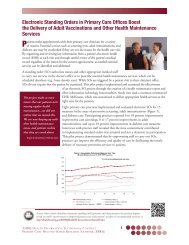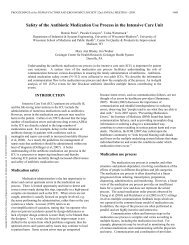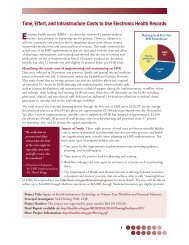Sustainability, Partnership, and Teamwork in Health IT Implementation
Sustainability, Partnership, and Teamwork in Health IT Implementation
Sustainability, Partnership, and Teamwork in Health IT Implementation
You also want an ePaper? Increase the reach of your titles
YUMPU automatically turns print PDFs into web optimized ePapers that Google loves.
Reasons for Not Susta<strong>in</strong><strong>in</strong>g or Not Implement<strong>in</strong>g<br />
Planned <strong>Health</strong> <strong>IT</strong><br />
When we compared the characteristics of the 29 projects that experienced one or<br />
more show-stoppers—reasons health <strong>IT</strong> was discont<strong>in</strong>ued or never implemented—<br />
with the 19 that did not, we found that a detailed implementation plan <strong>and</strong><br />
<strong>in</strong>tensive process redesign 5 prior to implementation were beneficial factors: only 45<br />
percent of those with a detailed implementation plan <strong>and</strong> 33 percent of those who<br />
engaged <strong>in</strong> <strong>in</strong>tensive process redesign experienced a show-stopper, versus 79 percent <strong>and</strong> 67 percent of<br />
other grantees (respectively, Figure 2.5). Other apparent differences were not statistically significant.<br />
The importance of a well-resourced partner organization with health <strong>IT</strong> expertise for susta<strong>in</strong><strong>in</strong>g<br />
the health <strong>IT</strong> was highlighted <strong>in</strong> the grantee <strong>in</strong>terviews perta<strong>in</strong><strong>in</strong>g to health <strong>in</strong>formation exchange<br />
projects <strong>in</strong> particular. And the struggle with how to f<strong>in</strong>ance HIEs cont<strong>in</strong>ued even for those that have<br />
been able to susta<strong>in</strong> their efforts (see box).<br />
Figure 2.5. Comparison of selected implementation features among grantees that did<br />
<strong>and</strong> did not experience a show-stopper<br />
100%<br />
90%<br />
80%<br />
<strong>Implementation</strong> grantees<br />
experienc<strong>in</strong>g a show-stopper (n=29)<br />
Implemention grantees not<br />
experienc<strong>in</strong>g a show-stopper (n=29)<br />
79%<br />
82%<br />
70%<br />
67%<br />
70%<br />
60%<br />
50%<br />
45%<br />
52%<br />
55%<br />
40%<br />
30%<br />
33%<br />
20%<br />
10%<br />
Source: Survey of THQ<strong>IT</strong> Grantees conducted <strong>in</strong> summer 2011.<br />
0%<br />
Intensive process redesign<br />
prior to implementation*<br />
Detailed implementation plan*<br />
<strong>Partnership</strong> <strong>in</strong>cluded hospital<br />
with 100 or more beds<br />
Involvement of targeted end users<br />
<strong>in</strong> plann<strong>in</strong>g was a strength<br />
Note: A grantee was categorized as experienc<strong>in</strong>g a show-stopper if it reported that one or more factors prevented<br />
implementation or forced discont<strong>in</strong>uation of a technology <strong>in</strong>volved <strong>in</strong> its project.<br />
*Statistically significant difference, p

















